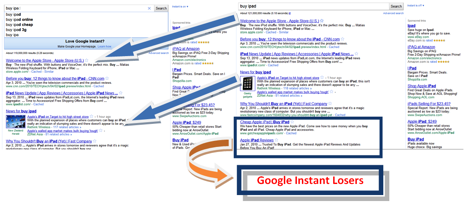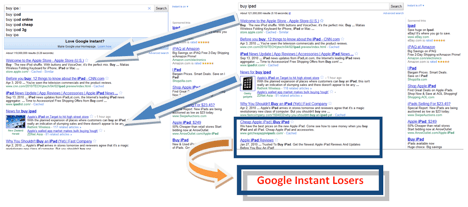
It’s been nearly two weeks since Google Instant launched, and aside from conjecture and personal opinions about the new UX (everyone seems to either hate it or love it), we’re finally starting to see some real data about how the new Google search experience is affecting organic traffic levels and other facets of SEO. Despite assertions to the contrary, SEO hasn’t been killed by Instant, but nor have the changes been inconsequential. Google Instant is slowly changing how search engine optimization professionals work, what they focus on, and the bottom line results seen by their clients.
When Google Instant first launched, we predicted three major SEO trends we expected to see. Since then, we’ve been collecting data from users of our SEO platform, Drive. Here’s how our guesses matched up with the results we’ve seen.
The Prediction
Real Estate is at a real premium in the age of Google Instant. A SERP that once showed seven or eight results above the fold now only has room for four or five results below the Google Instant suggestion dropdown. Based on this, we expected traffic to decrease dramatically for those results that Instant shoved below the fold. As a corollary, we expected traffic from above-the-fold keywords to rise, especially due to the general nature of Instant to present the searcher with more and more options to click those results, as they appeared automatically above the fold as he or she typed.
The Data
To test this theory, we focused on keywords that consistently ranked between position six and eight both before after the introduction of Google Instant, comparing how those keywords fared with counterparts ranking #1 through #5, and those in positions nine and ten. Focusing on such specific criteria gave us our smallest sample, but it was still large enough to be representative—and surprising. We actually found that once a user stopped typing, Google Instant was more likely to make the user scroll down the page: keywords in lowest positions showed the largest growth. Google Instant, however, seems to make searchers less likely to click to Page 2 of the results; keyword ranking past position #10 showed a significant decrease in traffic. Keywords that remained above the fold showed some growth, while keywords that had just dropped below the fold—where we expected to see the largest change—showed a barely-discernible decrease in traffic.
What To Do About It
Google Instant has changed how the SERP looks and how many results show, but—overwhelmingly—the behavior of most searchers to click on the top results hasn’t changed. Only now those top results are shown more often and are driving more traffic, so obtaining a top position is more important than ever. On the flip side, keywords ranking at the bottom of Page 1 are starting to get more attention, while keywords on subsequent results pages are tanking. Time to do that extra work to push your keywords from the top of Page 2 to the bottom of Page 1.
Long-Tail Keyword Compression
The Prediction
Our first prediction when Google Instant launched was that we would see less keywords driving approximately the same amount of traffic to sites—at least to well-optimized sites with a well-round keyword strategy. Because Google Instant focuses the user’s attention on more popular search phrases, by suggesting them and showing their results as the user types, fewer users will use longer tail, less popular phrases. Searchers typing a longer, more obscure variation of a keyword are unlikely to complete it before they see the results—automatically loaded onto the SERP—they were looking for.
A company selling iPod Car Adapters, but ranking for a lesser-used phrase, like “iPod Car Cables,” is unlikely to get much traffic from that phrase, as a searcher using Instant would almost never get to that search before seeing relevant results. For a site counting on unpopular, “forgotten” long-tail phrases like that, their traffic will dwindle. For sites ranking for a variety of relevant head and tail keywords, search volume will stay constant, even as query variety dwindles.
The Data
So far, this one is coming true in a major way. While organic traffic levels have risen about 5% for all Drive users since Instant was introduced, keyword variety has fallen more than 15%! Thousands of phrases are no longer driving any traffic, but most sites aren’t suffering for it.
What To Do About It
Firstly, take a deep look at your analytics. Find out which tail keyword phrases have stopped generating traffic, despite ranking well, and stop optimizing those phrases, shifting to your attention to the more popular variations of those phrases that are still generating traffic—and likely generating much more of it. Follow up with some keyword research—using Instant—to discover other popular varieties of those keywords that are showing up In Instant suggestions.
The Google Prude Paradox
The Prediction
One of the most interesting aspects of Google Instant is how much it put the search engine’s “prudishness” on display. Even with SafeSearch turned off, Google Instant will not show suggestions for adult terms or keyword phrases. We’d expect sites banking on adult terms, especially long-tail terms, to see little difference in organic traffic, since Google Instant basically doesn’t apply to them. Complementary to this, we’d expect sites that rank for “mature” but not necessarily “adult” terms—like “sexy videos” or “sexy girls”—to see slightly more traffic. As a searcher types a keyword phrase that starts out mature and gradually gets adult, the searcher might be enticed enough by a site showing up in the progressive results that has mature, but not adult, content.
The Data
We expected a slight increase in traffic. What we saw was huge: a more than 20% increase in traffic from “mature” keywords. A 25% increase in traffic from keywords containing the word “sex.” Google Instant is really changing user behavior here, waylaying a searcher intending to type an adult query with what is usually PG-13 content.
What To Do About It
This applies to a small group of sites, but if you have content that falls into that narrow band between Safe For Work and not shown with SafeSearch on, optimize that content as much as possible.
Conclusion
All this data comes with a large caveat emptor: it’s only been two weeks—long enough to see some data, but the data we’ll see in another month will definitely better illustrate the changes wrought by Google Instant. Full adoption of Google Instant—when it launches on mobile and in the browser address bar; when it is supported by more browsers and by those accessing Google through https on not via the home page (iGoogle, for instance)—will also further clear up these results. Some of the above may be disproven; other trends may continue. What’s certainly clear is that Google Instant has changed things, and SEOs need to react.
Data for this article was compiled by looking at the top 10 accounts in Drive and the approximately 10,000 tracked keyword driving traffic to their sites, along with the more than 60 million organic hits these sites received in the 13 days preceding and post the launch of Google Instant.
Eli Feldblum is the CTO & Co-Founder of RankAbove, the leading provider of scalable SEO solutions, intended for SEO professionals working at or on large web properties. Feldblum is an eight-year veteran of the SEO world, and has spoken and published throughout the industry. More predictions and data that either backs them or knocks them down is available here, and even more data will be available during a joint webinar between RankAbove and ComScore taking place on October 14th.
